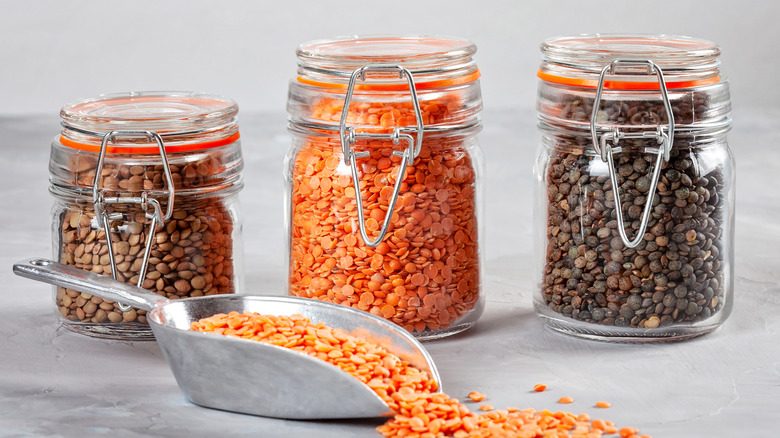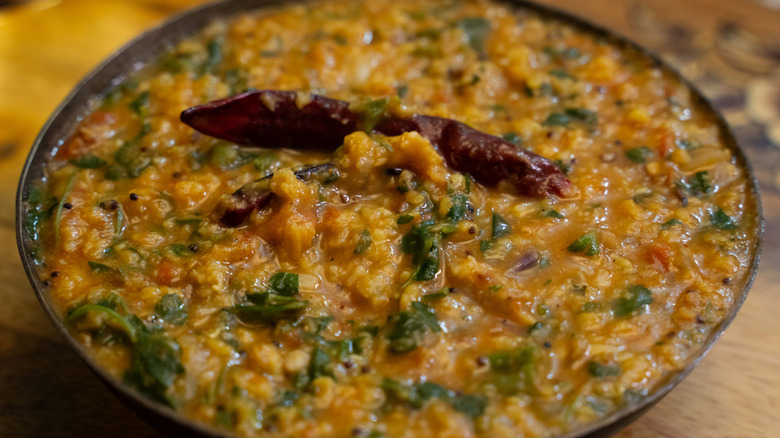The Secret To Storing Lentils And How Long These Nutrient-Packed Gems Last
Lentils are a frequently underrated (but undeniably nutritious) pantry powerhouse. Let's face it — you probably have a bag that's been kicking around, forgotten, for a few months at the back of your kitchen cabinet — but you really should be cooking with lentils more. They're not only packed with proteins and fiber, but their subtle earthy taste and texture make them a wonderfully versatile ingredient, equally at home in a homemade hummus as they are in an indulgent vegan sloppy Joe sandwich.
But with that versatility can sometimes come a little confusion, and a lot of you might not even be clear on exactly what they even are — are they beans? Grains? They're legumes, for the record, but this uncertainty can also leave people unsure of how they should be stored.
To find out more, we caught up with Karishma Pradhan, a recipe developer at Home Cooking Collective. "Dried lentils should be kept in an airtight container in a cool, dry location away from light," she told Food Republic. "Discoloration can occur from oxidation, which happens when lentils are exposed to light and warmer temperatures." If you can, you should also try to keep your lentils away from any kind of dampness or condensation: "Moisture can increase the likelihood of sprouting or mold," Pradhan warned us. So keep your lentils in a dark place — like your pantry or cupboard — preferably away from any sources of heat or liquid, and you should be good to go!
How long do dry lentils last?
There are many types of lentils out there. Black lentils — which are reminiscent of expensive beluga caviar – hold their shape and texture well and work wonderfully in salads and pilafs, for example. Green lentils are somewhat firm and are great in hearty dishes like this lentil noodle soup with greens. Luckily for home cooks, once those lentils are dried, they are all pretty much the same when it comes to storage — and they'll last you a very, very long time.
Exactly how long you should keep them is less a matter of whether they'll be safe to eat or not and more a question of quality. "Typically, dried lentils will maintain their quality for about one year after purchase (or the printed date) if stored properly," advised Karishma Pradhan. "While they remain safe to eat for many years, their quality will gradually decline, leading to longer cooking times and tougher textures." So while you can probably eat a pack of 2-year-old lentils, they won't necessarily set your palate alight.
When it comes to what type of lentils to buy, quality should come first. The crucial factor is the length of time the lentils are left between the point that they're harvested and when they're packaged and sold. "For best results, look for high-quality products from artisan businesses like Rancho Gordo or Baer's Best, which often have a shorter window between harvest and sale," Pradhan recommended.
How long can cooked lentils be stored?
Whether you're meal prepping or have simply made more lentils than you can handle at once, you'll probably end up saving some leftovers. Luckily, storage here is also a breeze. If you're planning on eating those leftover lentils within a relatively short time frame, you can keep them in the refrigerator. "Cooked lentils can be stored in the fridge in an airtight container for five to seven days," according to Karishma Pradhan.
If you want your lentils to last longer, and retain a good amount of their freshness and flavor, you should seriously think about freezing them. Despite the bad rap frozen food can get, it's a great way to efficiently prep meals in advance for those days when you just don't feel like cooking. You can keep your cooked lentils "sealed in individually portioned, airtight zip-top bags for three to six months," Pradhan told us. "After that point, the quality will start to deteriorate, so make sure you keep track of them for the best results."
It's a good idea to freeze them with a little extra cooking liquid — this will help preserve their texture. Then when you're ready to eat, here's the method Pradhan recommended: "Reheat gently on the stove over low heat until warmed through with a splash of water."



